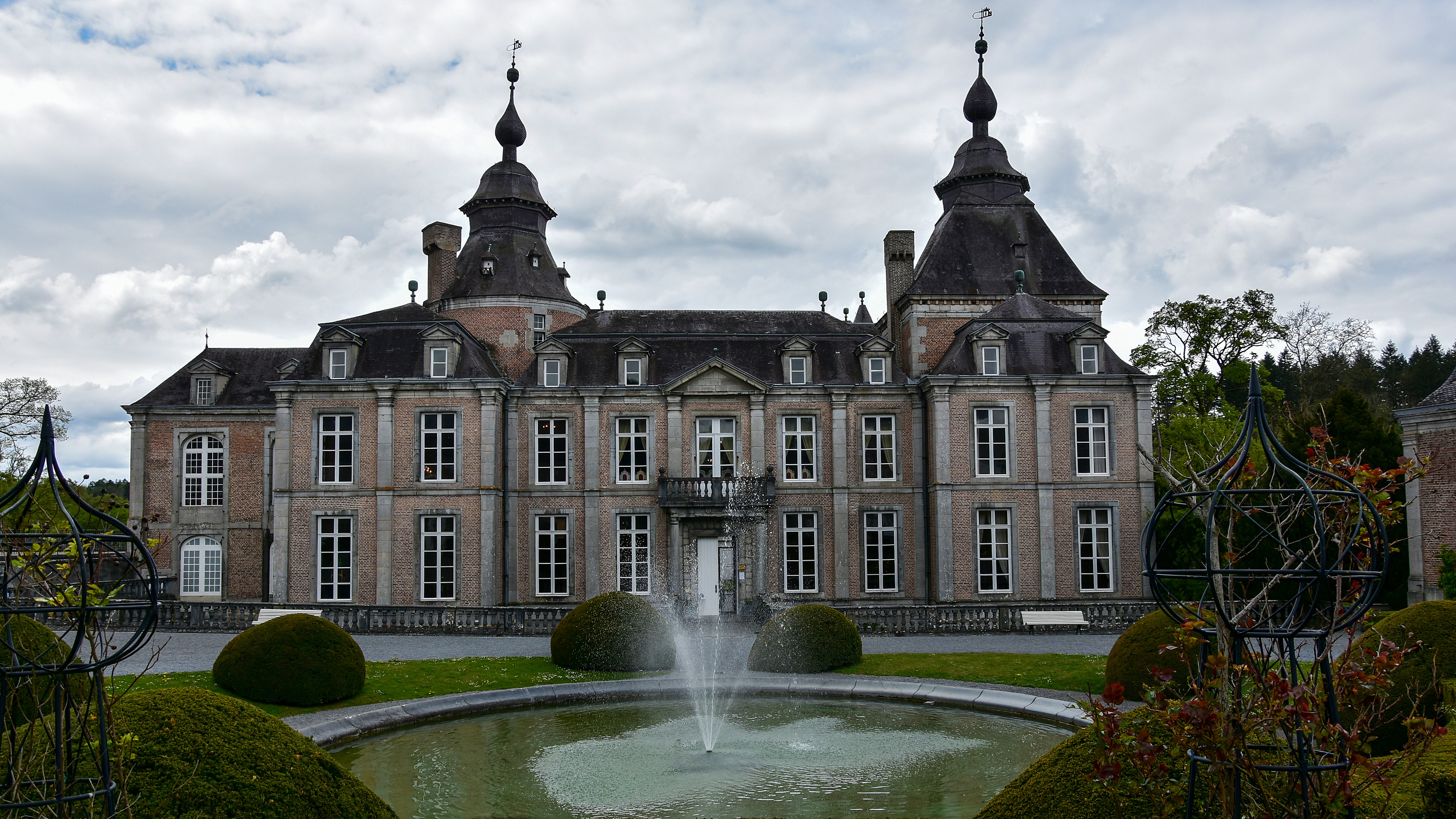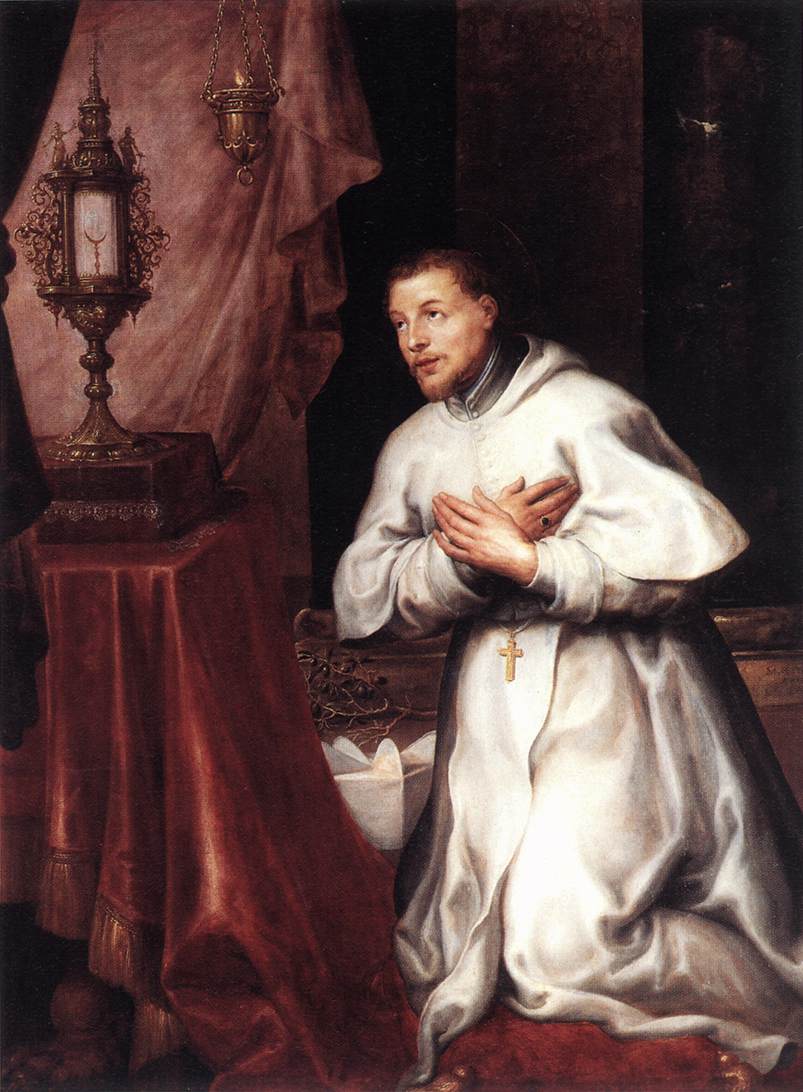|
Jan-Christian Hansche
Jan-Christian Hansche or Hanssche was a Flemish artist, possibly of German origin, who worked as a stuccoist in the Southern Netherlands, and also in Germany and Holland, in the second half of the 17th century. In 1672 he made the stucco decoration of the library of Park Abbey near Leuven in Belgium. The stucco relief represents the church fathers and the evangelists as well as scenes from the life of Saint Norbert. In the refectory of the same abbey he decorated the ceiling with seven biblical scenes (1679), signing his work "jan christiaen hansche". He also worked in several houses and monasteries in Ghent, in in Machelen and in Château de Modave. A magnificent example of his work are the decorations for Modave Castle. The grand vestibule of this castle is decorated with a genealogical tree of the house of the Counts of Marchin, including the coats of arms of the members of the family but also reliefs depicting some ancestors as knights in full armour on their horses. A s ... [...More Info...] [...Related Items...] OR: [Wikipedia] [Google] [Baidu] |
Refectory
A refectory (also frater, frater house, fratery) is a dining room, especially in monasteries, boarding schools and academic institutions. One of the places the term is most often used today is in graduate seminaries. The name derives from the Latin ''reficere'' "to remake or restore," via Late Latin ''refectorium'', which means "a place one goes to be restored" (''cf.'' "restaurant"). Refectories and monastic culture Communal meals are the times when all monks of an institution are together. Diet and eating habits differ somewhat by monastic order, and more widely by schedule. The Benedictine rule is illustrative. The Rule of St Benedict orders two meals. Dinner is provided year-round; supper is also served from late spring to early fall, except for Wednesdays and Fridays. The diet originally consisted of simple fare: two dishes, with fruit as a third course if available. The food was simple, with the meat of mammals forbidden to all but the sick. Moderation in all aspects of ... [...More Info...] [...Related Items...] OR: [Wikipedia] [Google] [Baidu] |
Katholieke Universiteit Leuven
KU Leuven (or Katholieke Universiteit Leuven) is a Catholic research university in the city of Leuven, Belgium. It conducts teaching, research, and services in computer science, engineering, natural sciences, theology, humanities, medicine, law, canon law, business, and social sciences. In addition to its main campus in Leuven, it has satellite campuses in Kortrijk, Antwerp, Ghent, Bruges, Ostend, Geel, Diepenbeek, Aalst, Sint-Katelijne-Waver, and in Belgium's capital Brussels. KU Leuven is the largest university in Belgium and the Low Countries. In 2017–18, more than 58,000 students were enrolled. Its primary language of instruction is Dutch, although several programs are taught in English, particularly graduate and postgraduate degrees. KU Leuven consistently ranks among the top 100 universities in the world by major ranking tables. As of 2021, it ranks 42nd in the ''Times Higher Education'' rankings, 70th according QS World University Rankings, 87th according to the Sha ... [...More Info...] [...Related Items...] OR: [Wikipedia] [Google] [Baidu] |
Hercules
Hercules (, ) is the Roman equivalent of the Greek divine hero Heracles, son of Jupiter and the mortal Alcmena. In classical mythology, Hercules is famous for his strength and for his numerous far-ranging adventures. The Romans adapted the Greek hero's iconography and myths for their literature and art under the name ''Hercules''. In later Western art and literature and in popular culture, ''Hercules'' is more commonly used than ''Heracles'' as the name of the hero. Hercules is a multifaceted figure with contradictory characteristics, which enabled later artists and writers to pick and choose how to represent him. This article provides an introduction to representations of Hercules in the later tradition. Mythology Birth and early life In Roman mythology, although Hercules was seen as the champion of the weak and a great protector, his personal problems started at birth. Juno sent two witches to prevent the birth, but they were tricked by one of Alcmene's servants and sent ... [...More Info...] [...Related Items...] OR: [Wikipedia] [Google] [Baidu] |
Marchin
Marchin (; wa, Mårcin) is a municipality of Wallonia located in the province of Liège, Belgium. On January 1, 2006, Marchin had a total population of 5,114. The total area is 30.00 km² which gives a population density of 170 inhabitants per km². The municipality consists of the following districts A district is a type of administrative division that, in some countries, is managed by the local government. Across the world, areas known as "districts" vary greatly in size, spanning regions or counties, several municipalities, subdivisions ...: Marchin, and Vyle-et-Tharoul. none, The Belle-Maison castle (18th century) See also * List of protected heritage sites in Marchin References External links * Municipalities of Liège Province {{Liege-geo-stub ... [...More Info...] [...Related Items...] OR: [Wikipedia] [Google] [Baidu] |
Genealogical Tree
A family tree, also called a genealogy or a pedigree chart, is a chart representing family relationships in a conventional tree structure. More detailed family trees, used in medicine and social work, are known as genograms. Representations of family history Genealogical data can be represented in several formats, for example, as a pedigree or . Family trees are often presented with the oldest generations at the top of the tree and the younger generations at the bottom. An ancestry chart, which is a tree showing the ancestors of an individual and not all members of a family, will more closely resemble a tree in shape, being wider at the top than at the bottom. In some ancestry charts, an individual appears on the left and his or her ancestors appear to the right. Conversely, a descendant chart, which depicts all the descendants of an individual, will be narrowest at the top. Beyond these formats, some family trees might include all members of a particular surname (e.g., male-li ... [...More Info...] [...Related Items...] OR: [Wikipedia] [Google] [Baidu] |
Modave Castle
Modave (; wa, Modåve) is a municipality of Wallonia located in the province of Liège, Belgium. On January 1, 2006, Modave had a total population of 3,722. The total area is 40.37 km² which gives a population density of 92 inhabitants per km². The municipality consists of the following districts: Modave, Outrelouxhe, Strée, and Vierset-Barse. The ''Château des Comtes de Marchin'' or Modave Castle is situated near the village of Modave. Rennequin Sualem built here what became the model for the famous Machine de Marly, which he invented. See also * List of protected heritage sites in Modave This table shows an overview of the protected heritage sites in the Walloon town Modave. This list is part of Belgium's national heritage. See also * List of protected heritage sites in Liège (province) This ... References External links * Municipalities of Liège Province {{Liege-geo-stub ... [...More Info...] [...Related Items...] OR: [Wikipedia] [Google] [Baidu] |
Château De Modave
Front facade The Château of Modave (french: Château de Modave), also known as the Château des Comtes de Marchin (''Château of the Counts of Marchin'') is a château near the village of Modave in Liège Province, Wallonia, Belgium. History The oldest part of the building, the donjon, was built on a strategic rock high above the valley of the river Hoyoux. The oldest parts still visible today date probably from the 13th century and were erected by the lords of Modave. In the 16th century the castle and the estate of Modave became the property of the Haultepenne and de Saint-Fontaine families. In the next century Jean-Gaspard-Ferdinand de Marchin (1601–1673), a great military commander, acquired the castle and turned it from a medieval fortress into a luxury Baroque residence. His son Ferdinand de Marsin neglected the property and lived in France. Later owners were successively: * Maximilian Henry of Bavaria, Elector of Cologne and Prince-Bishop of Liège (1682–16 ... [...More Info...] [...Related Items...] OR: [Wikipedia] [Google] [Baidu] |
Machelen
Machelen () is a municipality located in the Belgian province of Flemish Brabant. The municipality comprises the towns of Diegem and Machelen proper. On 1 January 2006 Machelen had a total population of 12,500. The total area is 11.59 km2 which gives a population density of 1,078 inhabitants per km2. Machelen may have been the birthplace of composer Cypriano de Rore. A portion of Brussels Airport is located in Diegem, Machelen.bedrijf.jpg ." Machelen. Retrieved on 25 April 2010. Economy  Brussels Airlines ...
Brussels Airlines ...
[...More Info...] [...Related Items...] OR: [Wikipedia] [Google] [Baidu] |
Ghent
Ghent ( nl, Gent ; french: Gand ; traditional English: Gaunt) is a city and a municipality in the Flemish Region of Belgium. It is the capital and largest city of the East Flanders province, and the third largest in the country, exceeded in size only by Brussels and Antwerp. It is a port and university city. The city originally started as a settlement at the confluence of the Rivers Scheldt and Leie and in the Late Middle Ages became one of the largest and richest cities of northern Europe, with some 50,000 people in 1300. The municipality comprises the city of Ghent proper and the surrounding suburbs of Afsnee, Desteldonk, Drongen, Gentbrugge, Ledeberg, Mariakerke, Mendonk, Oostakker, Sint-Amandsberg, Sint-Denijs-Westrem, Sint-Kruis-Winkel, Wondelgem and Zwijnaarde. With 262,219 inhabitants at the beginning of 2019, Ghent is Belgium's second largest municipality by number of inhabitants. The metropolitan area, including the outer commuter zone, covers an area of and had ... [...More Info...] [...Related Items...] OR: [Wikipedia] [Google] [Baidu] |
Saint Norbert
Norbert of Xanten, O. Praem (c. 1075 – 6 June 1134) (Xanten-Magdeburg), also known as Norbert Gennep, was a bishop of the Catholic Church, founder of the Premonstratensian order of canons regular, and is venerated as a saint. Norbert was canonized by Pope Gregory XIII in the year 1582, and his statue appears above the Piazza colonnade of St. Peter's Square in Rome. Early priesthood He adopted such strict discipline that it killed his first three disciples. This may be why he failed to reform the canons of Xanten, who denounced him as an innovator at the Council of Fritzlar in 1118. He then resigned his benefice, sold all his property and gave the proceeds to the poor. He visited Pope Gelasius II, who gave him permission to become an itinerant preacher and he preached throughout lands in what is now western Germany, Belgium, the Netherlands and northern France, being credited with a number of miracles. In settlement after settlement he encountered a demoralized clergy, ... [...More Info...] [...Related Items...] OR: [Wikipedia] [Google] [Baidu] |





